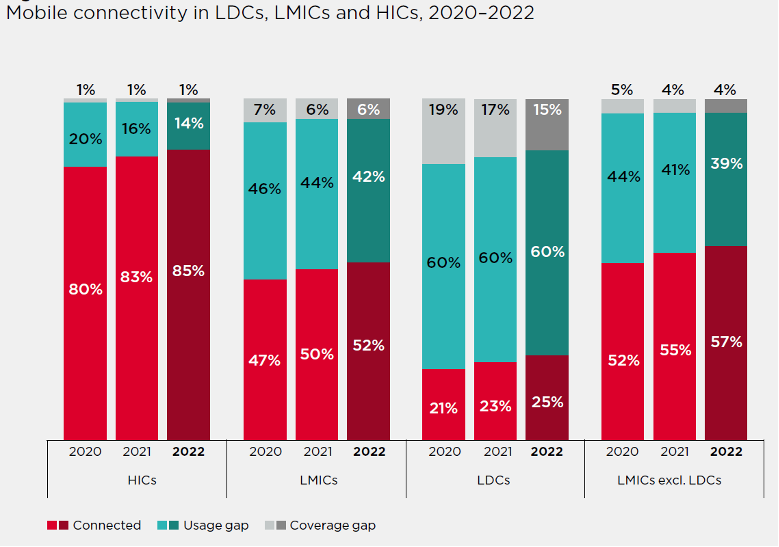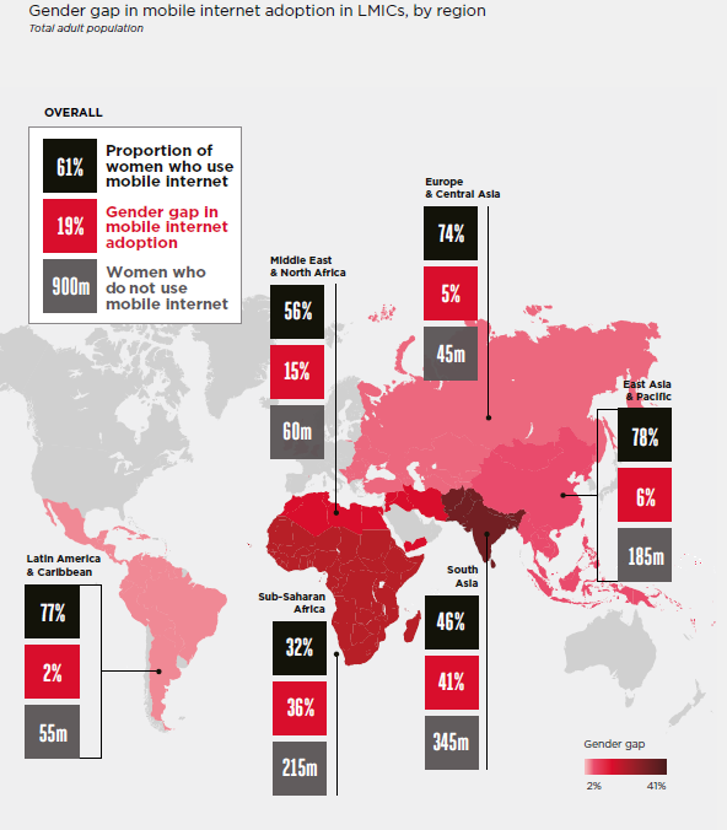Claire Sibthorpe, Head of Digital Inclusion, M4D, GSMA
As we consider the digital legacy we are leaving to current and future generations, we need to be mindful not only of the immense benefits that broadband and mobile connectivity have brought to the world, but also of the persistent digital divide which remains, and how we can work to overcome it.
Today, more people are connected than ever before using mobile as the primary – and often only – way to access the internet. This is transforming lives and creating unprecedented opportunities to achieve global development objectives. However, GSMA data show a significant digital divide remains, with 3.4 billion people excluded from the benefits of mobile internet. The unconnected are disproportionately women, poorer, less educated and living in rural areas. It is key that we address the barriers they face, to ensure we leave no one behind.
Connectivity varies by region, with 95% of the unconnected living in low- and middle-income countries (LMICs)
Of the unconnected, the vast majority (3 billion people, or 88%) live in areas already covered by mobile broadband, which is referred to as the usage gap1. The usage gap is largest in Sub- Saharan Africa (59%) and South Asia (52%). There is also a significant difference in uptake between least developed countries (LDCs) and LMICs. In LDCs, only 25% of the population use mobile internet, compared to 52% across LMICs overall and 85% in high income countries (HICs).
Women are behind at every stage of digital inclusion
Those who remain excluded from the benefits of mobile internet are disproportionately poorer, less educated, rural, persons with disabilities and women. Alarmingly, women’s rate of mobile internet adoption across LMICs slowed for the second year in a row in 20222. Women across these countries are now 19% less likely than men to use it, which translates into 310 million fewer women than men. There is also a 17% gender gap in smartphone ownership and a 28% gender gap in having a mobile money account. Even when connected, women tend to use mobile internet for a narrower range of activities and spend less on mobile services.

Source: ADB/GSMA blog: Working towards digital and financial inclusion of women in Asia and the Pacific
People in rural areas are also left behind: adults in rural areas are 29% less likely to use mobile internet than those in urban areas3. Rural women in LMICs are being left behind in particular. Even in countries where there is a small gender gap in mobile internet use overall, in the rural context the gender gap is notable4.
Reducing the digital divide requires a focus on addressing the barriers to mobile internet adoption
The digital divide is largely characterised by the usage gap. Therefore, governments, the development community, mobile operators and other stakeholders should work together to address the barriers to mobile internet adoption and use, considering the unique circumstances and needs of the underserved, especially women5:
- Affordability: Ensure more people can afford internet- enabled handsets and data services;
- Knowledge and Digital Skills: Increase awareness and understanding of mobile internet and its benefits, and develop digital skills strategies that help people meet their life goals and needs;
- Safety and Security: Address safety and security concerns and build user trust;
- Relevance: Support the expansion of local digital ecosystems with content, products and services that meet user needs and capabilities; and
- Access: Increase access to networks and enablers (e.g.
- electricity, agent networks, formal IDs) and improve the usability of handsets, content and services.
No single stakeholder can solve this challenge on their own. All stakeholders have a role to play and can do more to better measure, understand and address the barriers to digital inclusion to ensure everyone can benefit from an increasingly connected world.
- GSMA (2023) The State of Mobile Internet Connectivity Report 2023. (https://www.gsma.com/r/somic/) ↩︎
- GSMA (2023) The Mobile Gender Gap Report 2023. (https:// www.gsma.com/r/gender-gap/#:~:text=The%20Mobile%20Gender%20 Gap%20Report%202023&text=Gender%20gaps%20in%20smartphone%20 ownership,%25%20and%2017%25%2C%20respectively.) ↩︎
- GSMA (2023) The State of Mobile Internet Connectivity Report 2023. (https://www.gsma.com/r/somic/)
↩︎ - GSMA (2023). Rural women have so much to gain from mobile,but are being left behind. (https://www.gsma.com/mobilefordevelopment/ programme/connected-women/rural-women-have-so-much-to-gain-from- mobile-but-are-being-left-behind/) ↩︎
- See also Accelerating mobile internet adoption. Policy considerations to bridge the digital divide. (https://www.gsma.com/ mobilefordevelopment/resources/accelerating-mobile-internet-adoption-policy- considerations/) ↩︎
Claire Sibthorpe is Head of Digital Inclusion in the Mobile for Development (M4D) team at GSMA. She leads the Connected Women and Connected Society programmes which are focused on accelerating digital inclusion for the underserved in low- and middle-income countries. Connected Women has a specific focus on accelerating digital and financial inclusion for women. She has been working for over 25 years with public, private and international development organisations on social policy and service delivery with a focus on information and communications technology (ICT) policy and practice.







